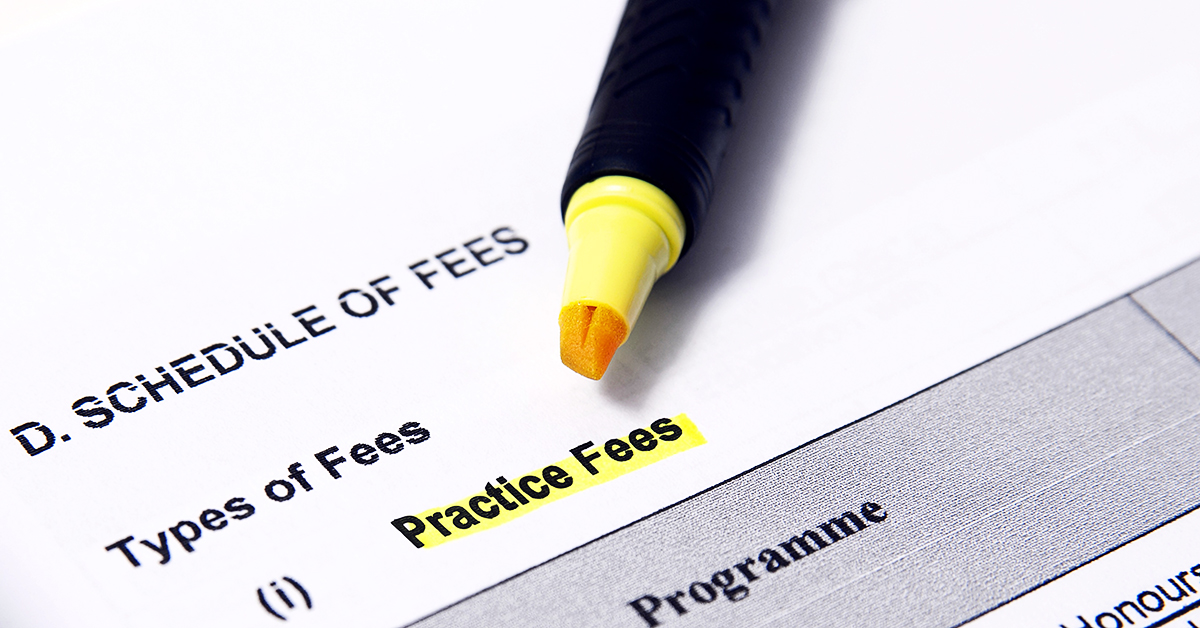Nobody likes increasing fees. Despite what many patients may think, that includes dentists. However, the truth is that just like the sun, fees must also rise.
Overhead certainly won’t decrease over the life of a practice. Yet, many dentists are afraid that if they raise their fees they will lose patients. Truth is, the only thing they sacrifice is profitability.
Keeping low fees are like a slow drain over time. The effects compound annually with every new piece of equipment purchased, staff salary increase and insurance payment adjustment. This path of diminishing profits can soon hit a pothole should you want to sell or bring on a partner into your practice. When fees are too low, it undervalues the practice. Also, when the new owner adjusts to meet the market, he or she may lose that loyal patient base they were sold on.
It’s Just Business
Fees are a natural part of doing business. Every single business needs to evaluate costs and adjust accordingly. That’s true whether you sell shoes or root canals. Patients expect fees to increase over time. If the adjustments are small and the level of service remains exceptional you’re not likely to hear a peep. An increase of $4 to $5 won’t have a huge impact on their pocketbooks but could have a significant impact on your bottom line.
If you think about it, raising fees is a lot like going to the dentist. No one really likes to do it, but if you put it off too long, it ends up being more uncomfortable than it needed to be in the first place.
Overcoming Your Fear of Raising Fees
For over 30 years, Steven J. Anderson and his team of practice advisors at the Total Patient Service Institute have helped practices of every shape, size and specialty re-engineer their approach to the business of dentistry. Along the way, they managed to dramatically increase practice production and profitability for thousands.
According to Steve, a practice owner should adjust their fees every 12 months. If you haven’t done a fee analysis in the past 12 months, schedule your fee increase today and make sure you do it at the same time every year. The best time is at the calendar change when insurance companies update their procedure codes.
Besides the turn of the calendar, there are other signs it’s time to examine your fee structure:
- Your fees are the lowest in your area
- You have no idea how your fees compare to your competition
- You are falling short financially
Pretty simple right? And so is the process of adjusting your fees. Why are so many dentists afraid to do it then? Steve has three reasons—and just like the fear of going to the dentist, they’re purely psychological.
Steve’s Top 3 Fee Fears
1. Approval Addiction – We all crave approval, but for many dentists the craving is even more acute. After all, they work in one of the few professions where customers will tell them to their face, “I hate the dentist.” Do not let a desire to win approval lead to undervaluing your services.
2. Fear of Losing Patients – Most people don’t take time to price shop for dental services. They initially go with whoever is on their plan, personal recommendations or location and typically will stay with them if they offer a comfortable experience. Also, does anybody really want to go to the cheapest dentist in town?
3. Fear of Criticism – We’ve established that patients don’t really shop around, so what are price criticisms based on? They base it on what they could have spent that money on, for example, if they didn’t have to get a crown they could have bought a new TV. Steve says just like any other medical provider, unless you are free you will be accused of being expensive. It’s important to work past this personal fear for the sake of your business.
The fact is that there are more emotions tied up in fee structures than most would like to admit-but it’s a business problem first and foremost.
What Should You Charge?
Every market and practice is unique, but the questions you should ask are the same whether you are in pediatrics or endodontics, in New York or New Mexico.
– What are other offices charging? – Steve recommends that your usual and customary fees should be in the 80th percentile in your market. This is where a partner like Cain Watters and Associates can help. Your CWA planner can grab the NDAS catalog and go procedure code by code to see how your fees compare to similar practices in your market. There’s no benefit in being in the 40% range when there’s always someone who will do it cheaper. The price game is a race you shouldn’t run in.
– What does the procedure cost you? – Materials, staff salaries, time spent; you must understand the margin associated for each procedure. Let’s say there is a lab you prefer to use for crowns, but they charge a premium. You may think they’re worth it and you are likely right, but your fee should reflect that premium expense.
– What is your time worth? – Dentists are notorious for undervaluing their time. You need to know what your time is worth by the hour. If you’re top in your field in full-mouth restorative dentistry and spend typically 3-4 hours or more with a single patient, what do you have to charge to make a single filling worth your time?
Insurance will also impact your fees. Just like a natural law, Steve reminds us that insurance companies are always at work to pull prices down.
Insurance dictates how much the patient portion of a procedure will be. Once a dentist signs the contract with a provider, they have lost control of the fee. Writing off the patient portion of the procedure fee is also a big no-no. If you stomach the difference between your $800 crown fee and the $600 insurance will pay, not only are you missing out on earned profit, but you expose yourself to getting audited for insurance fraud. In the end you want to land on a fee that accurately reflects costs and profit margin and is consistent with your market.
Tired of the insurance game? Check out the Total Patient Service Institute free e-book, “Should You Be Insurance Free?” for key questions every practice needs to ask around fees and their relationship to insurance.
Steve’s Tips for Managing Fee Changes
1. Do it every year – If your fees adjust a little every year no one is likely to notice except your accountant.
2. Don’t do anything drastic – Even if you find your fees are way out of whack you can’t jump from 40% of market to 80% overnight without turning off a lot of patients. Gradually increase 10-20% over a 2-3 year period to mitigate any negative perceptions.
3. Update fees procedure code by code – You might be OK on most of your fees and only need a few minor adjustments on a select number of procedures to get your overall percentage right.
4. Offer third-party financing options – Give your patients a variety of options to pay their bill, not just their insurance. Steve recommends having at least three different third-party payment options available to accommodate different patient financial needs.
Where to Start
Download CWA’s free “How Does Your Practice Compare? Report” to gut check your net income percentage. If your percentage is low while overhead is up, it’s another sign that it’s time to increase your fees. Have your CWA planner do a fee analysis for you—see where you stand when it comes to procedure fees. It’s time for all dentists to get paid what they are worth.
Don’t have a CWA planner yet? Contact a team member here for a complimentary consultation.














